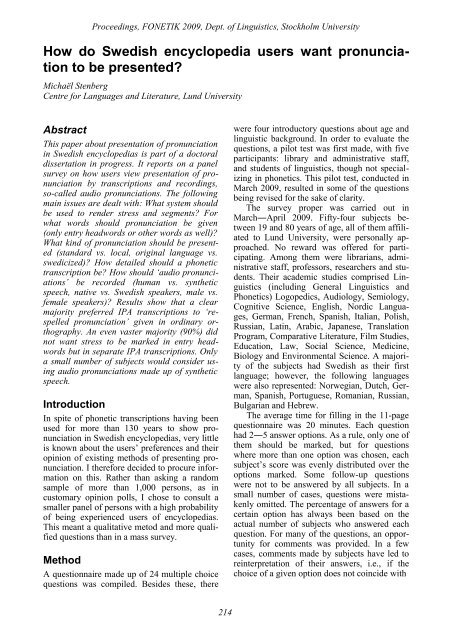Proceedings Fonetik 2009 - Institutionen för lingvistik
Proceedings Fonetik 2009 - Institutionen för lingvistik
Proceedings Fonetik 2009 - Institutionen för lingvistik
You also want an ePaper? Increase the reach of your titles
YUMPU automatically turns print PDFs into web optimized ePapers that Google loves.
<strong>Proceedings</strong>, FONETIK <strong>2009</strong>, Dept. of Linguistics, Stockholm UniversityHow do Swedish encyclopedia users want pronunciationto be presented?Michaël StenbergCentre for Languages and Literature, Lund UniversityAbstractThis paper about presentation of pronunciationin Swedish encyclopedias is part of a doctoraldissertation in progress. It reports on a panelsurvey on how users view presentation of pronunciationby transcriptions and recordings,so-called audio pronunciations. The followingmain issues are dealt with: What system shouldbe used to render stress and segments? Forwhat words should pronunciation be given(only entry headwords or other words as well)?What kind of pronunciation should be presented(standard vs. local, original language vs.swedicized)? How detailed should a phonetictranscription be? How should ‘audio pronunciations’be recorded (human vs. syntheticspeech, native vs. Swedish speakers, male vs.female speakers)? Results show that a clearmajority preferred IPA transcriptions to ‘respelledpronunciation’ given in ordinary orthography.An even vaster majority (90%) didnot want stress to be marked in entry headwordsbut in separate IPA transcriptions. Onlya small number of subjects would consider usingaudio pronunciations made up of syntheticspeech.IntroductionIn spite of phonetic transcriptions having beenused for more than 130 years to show pronunciationin Swedish encyclopedias, very littleis known about the users’ preferences and theiropinion of existing methods of presenting pronunciation.I therefore decided to procure informationon this. Rather than asking a randomsample of more than 1,000 persons, as incustomary opinion polls, I chose to consult asmaller panel of persons with a high probabilityof being experienced users of encyclopedias.This meant a qualitative metod and more qualifiedquestions than in a mass survey.MethodA questionnaire made up of 24 multiple choicequestions was compiled. Besides these, therewere four introductory questions about age andlinguistic background. In order to evaluate thequestions, a pilot test was first made, with fiveparticipants: library and administrative staff,and students of linguistics, though not specializingin phonetics. This pilot test, conducted inMarch <strong>2009</strong>, resulted in some of the questionsbeing revised for the sake of clarity.The survey proper was carried out inMarch―April <strong>2009</strong>. Fifty-four subjects between19 and 80 years of age, all of them affiliatedto Lund University, were personally approached.No reward was offered for participating.Among them were librarians, administrativestaff, professors, researchers and students.Their academic studies comprised Linguistics(including General Linguistics andPhonetics) Logopedics, Audiology, Semiology,Cognitive Science, English, Nordic Languages,German, French, Spanish, Italian, Polish,Russian, Latin, Arabic, Japanese, TranslationProgram, Comparative Literature, Film Studies,Education, Law, Social Science, Medicine,Biology and Environmental Science. A majorityof the subjects had Swedish as their firstlanguage; however, the following languageswere also represented: Norwegian, Dutch, German,Spanish, Portuguese, Romanian, Russian,Bulgarian and Hebrew.The average time for filling in the 11-pagequestionnaire was 20 minutes. Each questionhad 2―5 answer options. As a rule, only one ofthem should be marked, but for questionswhere more than one option was chosen, eachsubject’s score was evenly distributed over theoptions marked. Some follow-up questionswere not to be answered by all subjects. In asmall number of cases, questions were mistakenlyomitted. The percentage of answers for acertain option has always been based on theactual number of subjects who answered eachquestion. For many of the questions, an opportunityfor comments was provided. In a fewcases, comments made by subjects have led toreinterpretation of their answers, i.e., if thechoice of a given option does not coincide with214
















